Dr David Guex
January 2013 - Erbium:YAG laser website
Download the PDF
Physical principles and functioning
The Erbium:YAG laser (Er:YAG) is now the laser with the most indications in omnipractic. Its wavelength of 2.940 nanometers is located on one of the absorption peaks of water and hydroxyapatite (Fig. 1). It can be described as an infrared laser with low thermal propagation therefore little penetrating, if used under water spray of course. The point of interaction with the target tissue is via the water molecule, which considerably reduces the thermal effect (Fig. 2).
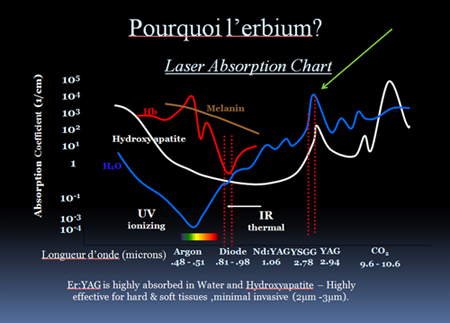
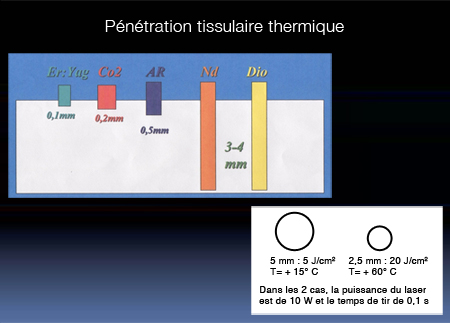
When an Er:YAG laser strikes a target, the non-specific photo-ablative effect corresponds to a pure ablation of the target material, via water, without visible thermal damage on the banks, as would be the case a scalpel (Fig. 4).
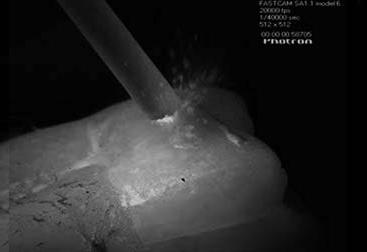
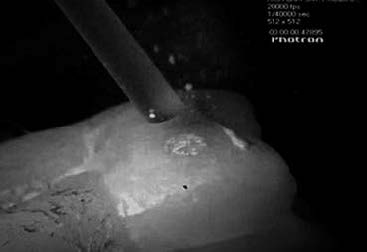
This ablative photo effect is obtained by the principle of photodissociation, with very short pulses of very energetic waves (0.150 to 0.600 μm): Er:YAG = 0.2940 μm (Fig. 3). This ablative photo effect is generated by water that completly absorbs radiation, and also by hydroxyapatite when the laser treatment occurs on hard tissues but to a lesser extent. This rapid absorption is translated by a brutal thermal effect (120 to 250 us), which produces a sublimation of the water, accompanied by a strong increase in intra - tissue volume over an impact thickness of 5 μm. This micro - explosion is linked to this change of state of water, passing from a liquid state to a gaseous state. This causes a tearing of material which will be evacuated by the release of immediate steam (the origin of some projections). This phenomenon characterizes the Er:YAG (2.940 nm) and Er, Cr: YSGG (2,780 nm) lasers, called an explosive vaporization 10, 11 (Fig. 3). Simply put this slide (Fig.4) describes the process of destruction of the operated tissues: the wavelength of the laser will encounter a molecule of water, these will swell in volume and then burst. 8 This burst gasifies the tissue impacted by laser shooting. Er:YAG is the only laser to cause explosive vaporization, due to its wavelength. The thermal energy is absorbed in 5 microns of water and the thermal damping is done on a few microns depending on the nature of the fabric. So there is no carbonization is the thermally affected layer is weak.
The effects of Er:YAG laser (ergonomics, ablative photo effects, biostimulation)
Ergonomics
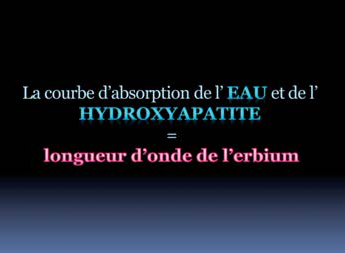

Advantages of tips in relation to the surgical cutter.
The latest technologies on the market allow us to have more and more fine tips, which improves their ergonomics (Dr Girot: dental info, September 2012). The laser tips are today miniaturized which clear our operating field. We no longer have the head of the contra-angle in view of the operated area, so we have less blind spot. The mode of transmission has changed and the optical cavity is in the hand cavity, we have much less energy loss which increases our working speed (Fig. 6).On the other hand, the use of burs sometimes generates vibrations, the burr rebounds along the cortical depending on the attack angle. This phenomenon is stressing in front of noble anatomical structures. With the tip, we work at the distance which allows us to see what we do from where the interest of having optical aids. In fact, if we had to pick an image: it would be the one from the optical drill. This transparent cutter is actually a beam of light consisting solely of photons vibrating at 2.940 nm wavelength.
Utility of Er:YAG laser on tissues
Photo-ablative effect: Er:YAG laser cuts and removes soft and hard tissue
- Action on soft tissue: the granulation tissue consists essentially of water, therefore we have an excellent vaporizing effect of the granulation tissue. The use of tips is more efficient and faster than curettes. Laser treatment results in a reduction in periodontal inflammation decreasing levels of cytokines pro-inflammatory IL-1f 3 and TNF-A.7. A fluorescent technique shows that Er:YAG laser irradiation prevents from a rapid process of recolonization of the tissue of granulation. The Er:YAG laser has shown the high bactericidal potential against the pathogenic Pg bacterium, specific to periodontitis.
- Action on the hard tissue: bone tissue consists of tricalcium phosphate, however the wavelength of Er:YAG corresponds to the absorption curve of water and hydroxyapatite and (Fig.5). When we make a shot we get a crater on the impact, bone tissue vaporizes (Fig.7). As the material is sublimated during laser shooting on the bone there is no longer any deposit in the alveoli by the milling tips. We obtain a cleaning of the micro-alveoli while preserving the micro-vascularization. This effect is similar to endodontic. In fact when we activate the irrigation solution, we have a phenomenon of rise of the smear, giving a cleaner surface condition of the dentin walls. The sectioned tissue does not have to digest the milling sludge.
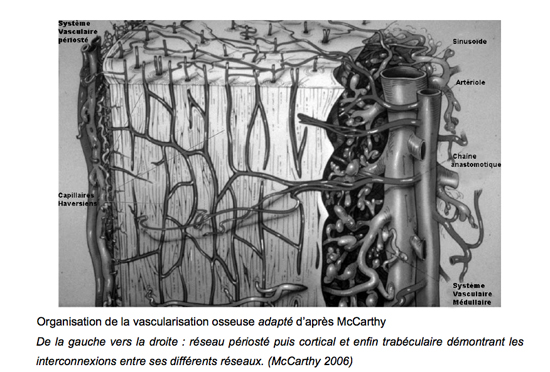
Fig. 7: Organization of the bone vascularization adapted according to McCarthy. From left to right: periosity system then cortical and finally trabecular showing the interconnections between its different root canals. (McCarthy 2006) - The decontamination of the implant surface: the use of Erbium:YAG allows the treatment of peri-implantis. The curette can not clean the surface condition of the implant turns. The Er:YAG laser generates a sterilization of the surface state, thus allowing recolonization of the bone cells on a clean and decontaminated implant surface. That's all the difference between a macroscopic cleaning with a curette and a molecular laser cleaning. In addition, the wavelength of Er:YAG has no impact on the metal. This allows us to clean the implant turns at high magnification by restoring a clean surface condition. There is no melting of titanium on the surface.
Biostimulation
The number of fibroblasts is multiplied by 30 on a site irradiated with the laser Er:YAG: the healing is therefore accelerated. An erbium-treated bone has a markedly increased regeneration and healing capacity compared to any other osteotomy method: this is the benefit produced by the photo-modulation effect (Fig. 8).
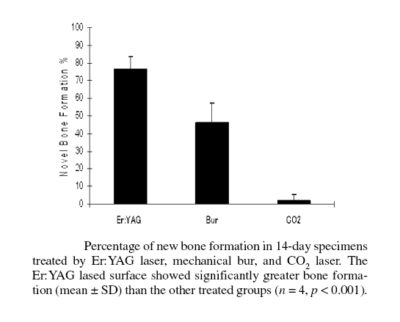
Clinical case
A patient came to the first consultation on 9-11 2004, for an apical granuloma at the apex of an implant instead of 45. The patient does not follow-up (Fig.9). She comes back 4 years later 21 02 2008 during a new control consultation. On the radiography examination we find that the granuloma has spread to the apex of the 44 (Fig. 10).
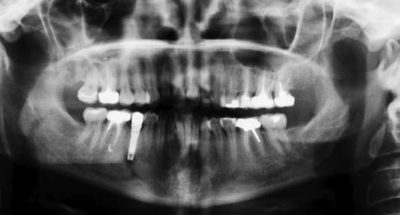
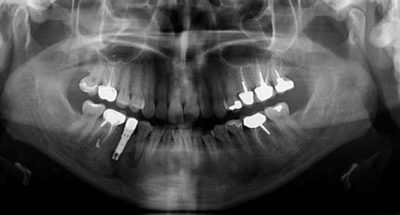
First intervention: we performed the root canal 44. The percussion tests were negative and the vitality tests were inconclusive to our great astonishment the tooth was alive.
The patient returns several times because of abscesses: masseterine cellulitis (Figs 11a-c). Note the vestibular cortical blown in front of 44 (Fig.12) as well as the close relationship between the mentor foramen and the cyst (Fig. 13).
Surgery 02-06-2010 : a Er:YAG laser surgery was decided in order to cut the apex of 44 and to eliminate all of the cyst on the 44 tooth and on the apex of the implant.
Figs. 11a-c: abscess: cellulite masseterines (c) Office Sevain / Guex
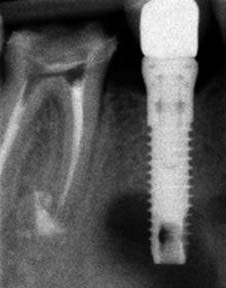

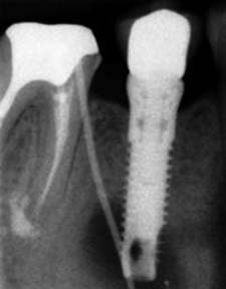
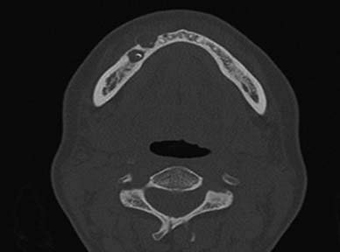
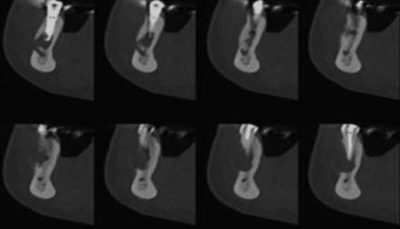
The Er:YAG use in this very case was safe and reassuring, we never quite comfortable to use a drill facing the mental foramen. As we've already seen it, the Er:YAG laser is an extremely precise surgical tool. It allows us to safely operate in delicate areas and to approach anatomical structures such as the mandibular nerve by minimizing the risks of serious lesion. The interest of this surgical tool resides in its action of tissue microablation. We make a very precise osteotomy with a clear operational field. Since Er:YAG is very strongly absorbed by the hydrated tissues, we have no action on the adjacent tissues and the vascularization of the operated tissue is preserved. Given the importance of the destruction, we first want to eliminate the totality of the cystic lesion to benefit from the bio simulation of Er:YAG in order to induce a reconstruction of the bone density. In the present case the use of the Er:YAG laser has given us several advantages:
- Vaporization of the cystic tissue was much faster than the use of a simple curette. We had more comfort in going to the blind spots. The irrigation provided by the laser allowed us to evacuate the cystic tissue, the surgical site was well clear.
- No curette could clean the apical implant vent, the fineness of the tips of the Er:YAG allows a cleaning of this vent and implant turns.
- We were able to recover an original implant surface by surface sterilization (Figs.14 and 15).
The postoperative course was particularly discreet.
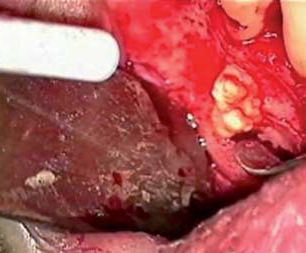
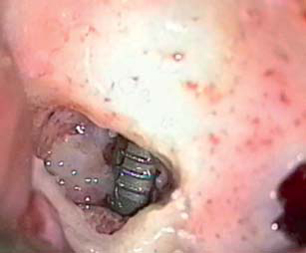
Controls and monitoring
Figs. 16a and b: Control radiographs after 6 months. (c) Office Sevain / Guex
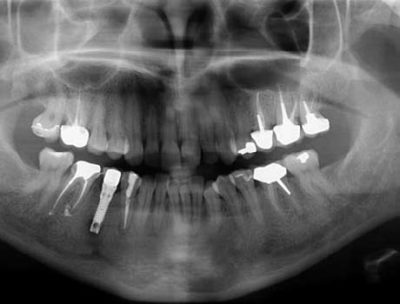
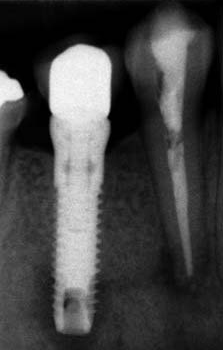
The result obtained on the lesion of 44 is quite satisfactory. We have exploited to the maximum the regeneration potential of the bone lesion (Figs 16 a and b). The lesion is now "decompressed". Radiographically, we note a clear radio image at the apex of the implant, centered on the implant vent, which justifies a second intervention (Figs 17a-d).
Figs. 17a-d : Controls and follow up after 12 months (c) Office Sevain / Guex
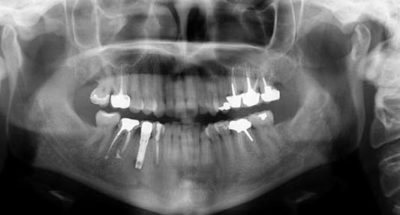
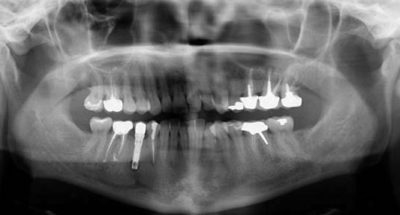
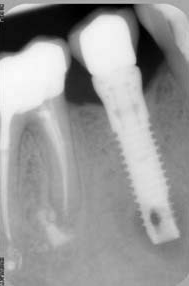

Re-surgery on 09.07.2012
At this precise moment, the reconstructed bone volume is important, the vestibular table and reconstituted including at the level of 45. In order to reach the apex of the implant, we had to proceed with a bone release with respect to the apex of the implant. We were guided by the trace of a slight bone fistula. The section of the implant vent is made with the transmetal drill under abundant rinsing. We were able to cut at a minimum the apical part of the implant (Figs 18a and b). No bio material or FRP was used at this stage.
Figs. 18a and b: Re-surgery 14 months later (c) David Guex

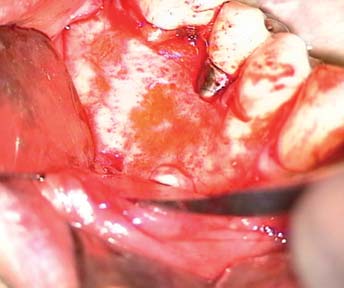
Er:YAG laser surgery results can be explained by several factors:
- Improvement of angiogenesis.
- Increase factors of croissance.
- Optimization of the inflammatory response (Fig. 19a and b).
Figs. 19a and b: Accelerated bone regeneration. (c) David Guex
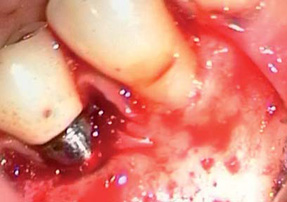
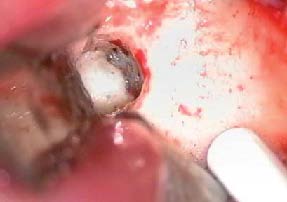
Note the presence of a solid body in the implant vent (Figs 20 and 21 (c) David Guex).
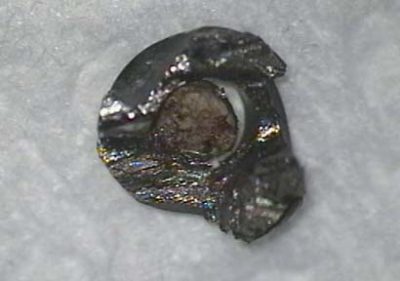
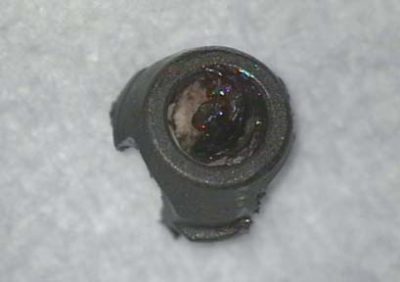
Result
Please note X-ray (Figs. 22 to and b) and clinical (Figures 23 to and b) at three months (05.10.2012). Our patient no longer complains of pain.
Figs.22a and b: Radiographic examination three months after re-surgery. (c) David Guex
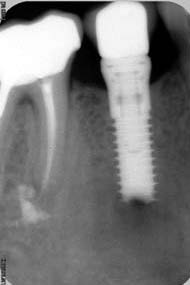
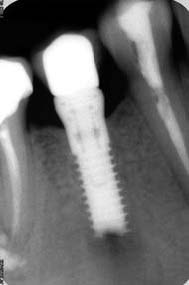
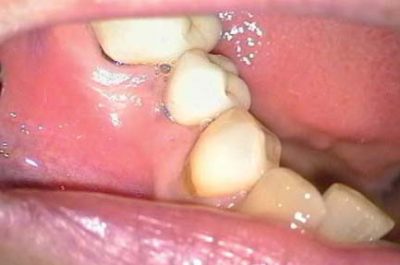
Conclusion
The lesson to be learned from this clinical case is that the apex of this implant had to be treated as the apex of a natural tooth: that is to say resecting it. However, the interest of Er:YAG in this approach was to reconstruct a maximum of bone tissue and then resect the implant. Nowadays the advantage of using an Erbium:YAG laser in surgery lies in the accuracy of tissue ablation even in blind spots, in the quality of the bone reconstruction induced during the cicatrization of the mucosa after biostimulation.
Acknowledgments: I would like to thank Dr. Pierre-Yves Pahaut for his help during the surgery, and Doctors Jean François Sevain, Pascal Bufflier, and Fabrice Baudot for their help in correcting this article. This surgery was carried out in the Dental Office of Doctors Sevain.
General practitioner in Villié-Morgon (France) since 1999.
Exclusive endodontist in Bron (France) since 2009.
University degree in anatomy and cranio-cervico-facial dissection of the Faculty of Medicine of Paris.
Bibliography
Art 1 Initial fibroblast attachment to Erbium:YAG laser-irradated dentine, Bolortuya and coll, International Endodontic Journal, 44, 1134-1144, (December 2011).
Art 2 Ultrastructural Analysis of Bone Tissue Irradiated by Er:YAG Laser, Katia M. Sasaki and coll, Lasers in Surgery and Medicine 31:322–332 (2002).
Art 3 A laser Doppler study of gingival periosteal stimulation, Pascal Ambrosini and coll, J Clin Periodontol; 29: 103–107, (2002).
Art 4 Periodontal Tissue Healing Following Flap Surgery Using an Er:YAG Laser in Dogs, Koji Mizutani and coll, Lasers in Surgery and Medicine 38:314–324 (2006).
Art 5 Indications and limitations of Er:YAG laser applications in dentistry, Carl Bader and coll, American Journal of Dentistry;19: 178-186, (2006).
Art 6 Platelet Derived Growth Factor Secretion and Bone Healing After Er:YAG Laser Bone Irradiation, Gavriel Kesler, Journal of Oral Implantology, 195-204, Vol. XXXVII/Special Issue, (2011).
Art 7 IL-1b, TNF-a, Total Antioxidative Status and Microbiological Findings in Chronic Periodontitis Treated With Fluorescence-Controlled Er:YAG Laser Radiation,Arantza Dominguez and coll, Lasers in Surgery and Medicine 42:24–31, (2010).
Art 8 Quel est l’intérêt du laser dans le nettoyage canalaire, Guex.D, Dentoscope n°101, 38-46, (Septembre 2012).
Art 9 The use of the LiteTouch Er:YAG laser in peri-implantitis treatment, Prof Tzi Kang Peng and coll, laser 3, 22-28, (2012).